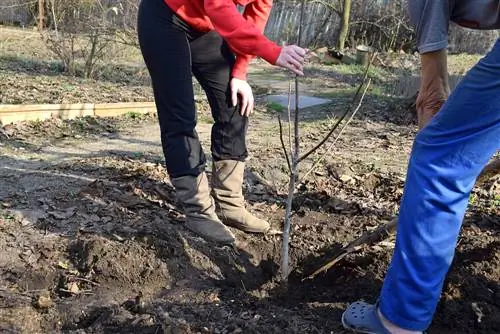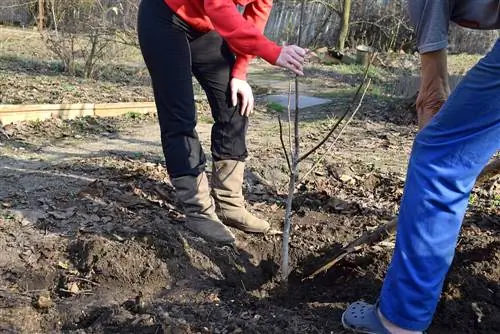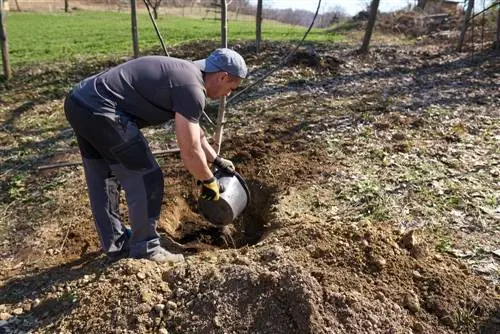- Author admin [email protected].
- Public 2023-12-16 16:46.
- Last modified 2025-01-23 11:21.
The walnut tree grows into an impressive beauty over the years - it reaches an impressive size, both in length and width. In order to be able to grow this enchanting plant on your doorstep, you need a lot of space in the garden. With our extensive information, you will be able to plant a walnut tree that will give you decades of joy!

How can I successfully plant a walnut tree?
To plant a walnut tree, you should choose the right time, prepare the soil, plan enough space and plant and stabilize the tree properly. Ideal planting times are mid-April and September/October. Make sure there is sufficient watering and frost protection.
What is important when planting a walnut tree
If you want to plant a walnut tree, you need to consider several points:
- the right time for planting
- the properties of the soil
- the space required (including the distances)
- the direct approach to planting
The right time to plant a walnut tree
In principle, you can plant a walnut tree in spring, summer or autumn - in mild regions even until mid-November or even longer. But: Young walnut trees are sensitive to frost, so we advise you to avoid the last late frosts in spring and the first early frosts in autumn.
Our recommendation: Plant your walnut tree either in mid-April or otherwise in September/October.
It is important that you only plant the walnut tree when the soil has a certain level of warmth. This means that in the spring it is better to wait a few days after a cold snap; after all, there is no stress. Conversely, you shouldn't take too long in autumn.
Advantage of autumn versus spring planting: The walnut tree still develops fine roots until permanent frost occurs. These roots make it easier for it to absorb enough water next spring. Good rooting promotes successful growth, especially during heat periods that occur quite early.
Attention: If you live in an area where frosts in September/October are more typical, you should give preference to spring planting. Then you have to water the tree sufficiently, especially in the budding phase.
Soil properties required for planting
A walnut tree is long-lasting and undemanding - also in terms of the substrate. It thrives in diverse soils and landscapes. Nevertheless, he has specific preferences - and at the same time knows what he doesn't like.
The floor should
- moist,
- slightly sandy,
- profound as well as
- slightly sour to neutral
be.
However, alkaline soils are not a problem for a walnut tree.
The floor should NOT
excessively sandy
be.
Furthermore, a walnut tree does not like waterlogging and/or poorly ventilated soil. Under such conditions it grows very slowly and hardly produces anything.
The space required for planting walnut trees
Depending on the nature of the soil and what variety it is, the space required and the required planting distances vary.
An ungrafted seedling
- grows more in width and
- therefore requires more space.
15 x 15 meters of free space is ideal, especially in deep soil (rapid growth).
A refined walnut tree
- grows more in height and
- therefore requires less space.
12 x 12 meters of free space is ideal; if the soil is poor (slow growth), 10 x 10 meters is sufficient.
In the first 30 years, a walnut tree grows mainly upwards. Then it has mostly reached its final height. The crown now begins to grow in width.
Here is an overview of the recommended minimum distances:
- eight to ten meters to the house and walls
- six to eight meters to garage or carport
- at least ten, preferably 15 meters to fruit trees
- eight to ten meters to the next property
If you do not maintain these distances, the roots and later the branches can cause serious damage, for example to the masonry.
The direct approach to planting
- Prepare a planting hole 80 to 100 centimeters wide and at least 50 centimeters deep. Loosen the soil even deeper if it is very firm - otherwise the important taproot can only spread slowly.
- Enrich the planting hole with fresh compost or a slow-release fertilizer - this way you ensure the initial supply of nutrients.
- As soon as the walnut tree is solid in the planting hole, fill it with high-quality potting soil (€14.00 on Amazon). If the excavation contains humus and is mixed with mature compost, you can use it instead of potting soil.
- When planting your walnut tree, be sure to soak the soil thoroughly to ensure that it gets into the spaces between the roots.
- Tread the earth.
- Water the soil again.
- Water the growing tree generously in the first few weeks - especially in warm weather.
Important: The young walnut tree grows quickly. To ensure that it can withstand rapid growth, a stabilizing post is essential. Place the stake at the edge of the planting hole (preferably in front of the walnut tree). A support post around 1.5 meters long is ideal. The post must be buried at least 60 centimeters - only then will it be secure and able to hold the tree. Choose high-quality wood right from the start so you don't have to replace the post over the years. Good woods are oak and robinia.
Tip
By painting it white in the first few years, you can reliably protect your walnut tree from frost damage.






